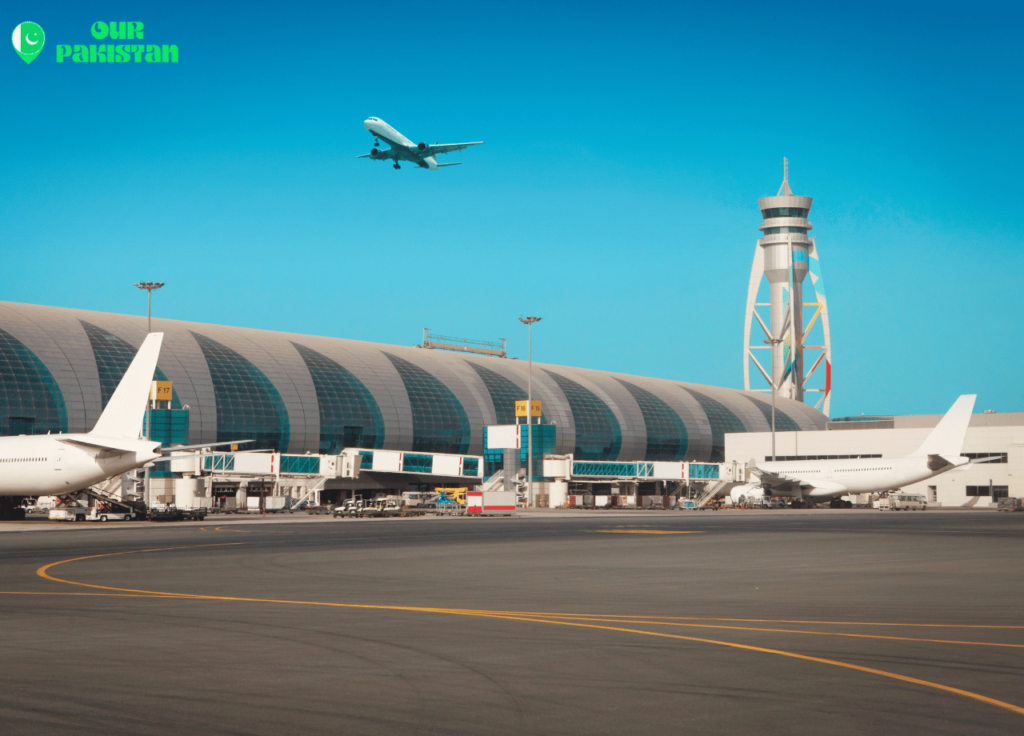Navigating through airports in Pakistan is an experience that reflects the country’s rich cultural heritage and rapid modernization. As the gateways to Pakistan’s bustling cities and picturesque landscapes, these airports play a pivotal role in connecting Pakistan with the global village. Managed by the Civil Aviation Authority, each airport in Pakistan contributes significantly to the nation’s economy by facilitating international and domestic flights. With amenities ranging from robust air traffic control systems to plush VIP lounges, Pakistani airports are equipped to serve the diverse needs of travelers from around the world.
This article will navigate through the top 5 airports in Pakistan, offering an in-depth look at their facilities, operational capabilities, and contributions to both local and international air travel. From the bustling runways of Jinnah International Airport in Karachi and the historic significance of Allama Iqbal International Airport in Lahore to the architectural marvel that is Islamabad International Airport, these hubs of air travel are integral to Pakistan’s connectivity. Additionally, we will explore Faisalabad International Airport and the strategically important Gwadar International Airport, shedding light on their roles in bolstering regional and international commerce. Through this exploration, the article aims to provide travelers and aviation enthusiasts with valuable insights into the air gateways of Pakistan.
Jinnah International Airport, Karachi
Jinnah International Airport, the largest airport in Pakistan, is strategically located in Karachi, Sindh. Named after Muhammad Ali Jinnah, the founder and first Governor General of Pakistan, this airport serves as a central hub for both domestic and international flights.

Jinnah International Airport Terminals
The airport features a single main terminal, which is divided into two concourses spread across five floors. The Jinnah East Satellite Concourse primarily handles international flights, while the Jinnah West Satellite Concourse is dedicated to domestic operations. This division efficiently manages the flow of passengers and streamlines airport operations.
Jinnah International Airport Runways
Equipped with two major runways, the airport can accommodate a wide range of aircraft, including the Boeing 747-400, Airbus A350 XWB, and Antonov An-225 Mriya. The runways, measuring 3,200m and 3,400m in length, are designed to handle up to 15 flights per hour. Both runways, 25R/07L and 25L/07R, are equipped with Instrument Landing Systems (ILS CAT-I), ensuring safe landings even under adverse weather conditions such as fog.
Jinnah International Airport Cargo Operations
Jinnah International Airport is not only pivotal for passenger traffic but also plays a significant role in cargo operations. It hosts a variety of cargo airlines, including DHL Aviation, MNG Airlines, and Qatar Cargo, connecting Karachi with major global destinations like Abu Dhabi, Bahrain, and Doha. The airport’s cargo facilities are robust, with a taxiway that can handle 12 aircraft simultaneously and a parking area of 266,000 sq meters that accommodates 42 aircraft, including 12 via air bridges and 30 in remote parking bays.
This airport is best known for its comprehensive facilities that cater to both passenger convenience and cargo efficiency, making it a crucial asset in Pakistan’s aviation sector.
Allama Iqbal International Airport, Lahore
Allama Iqbal International Airport, located in Lahore, Punjab, stands as the third-largest civilian airport by traffic in Pakistan, following Jinnah International Airport and Islamabad International Airport. Serving as a vital link for Lahore, the capital of Punjab and Pakistan’s second-largest city, the airport also caters to a significant number of travelers from other regions of Punjab.
Allama Iqbal International Airport Terminals
The airport is equipped with three terminals: the Allama Iqbal terminal, the Hajj terminal, and a dedicated cargo terminal. These facilities ensure efficient handling of passengers and goods, reflecting the airport’s capability to manage large volumes of air traffic.
Allama Iqbal International Airport Runways
Featuring two parallel runways, one constructed from concrete and the other from asphalt, Allama Iqbal International Airport is designed to accommodate a variety of aircraft. The primary runway, 36R/18L, extends 3,360 meters and is equipped to handle large aircraft like the Airbus A380. The secondary runway, 36L/18R, measures 2,743 meters and can accommodate the Boeing 747-400.

Allama Iqbal International Airport Cargo Operations
The airport’s cargo operations are robust, with services provided by Pakistan State Oil ensuring a steady supply of Jet A-100 fuel to all departing flights. The airport also offers comprehensive fire fighting and rescue services, classified under Category 9, alongside cargo and luggage wrapping services. Notable cargo airlines operating from this hub include DHL Aviation, Egypt Cargo, and Qatar Cargo, connecting Lahore with major international destinations such as Abu Dhabi, Bahrain, and Cairo.
Islamabad International Airport
Islamabad International Airport, inaugurated in 2018, stands as a modern gateway to Pakistan, replacing the older Benazir Bhutto International Airport. It is strategically located to connect Islamabad via the Srinagar Highway and Rawalpindi via the GT Road, enhancing accessibility and efficiency for both passengers and cargo operations.
Islamabad International Airport Terminals
The airport boasts a 180,000m² modular terminal building designed to handle up to 9 million passengers annually, with projections to serve 25 million by 2024. It features a comprehensive layout with 15 gates, including ten remote gates, duty-free shops, a food court, and 42 immigration counters, facilitating a smooth and efficient passenger experience.
Islamabad International Airport Runways
Equipped with two major runways, Islamabad International Airport can accommodate the largest aircraft, including the Airbus A380, marking it as the only airport in Pakistan with this capability. The runways are well-constructed to support significant air traffic, contributing to its status as a major cargo hub in the region.
Islamabad International Airport Cargo Operations
The Shaheen Cargo Terminal at Islamabad Airport is a pivotal element in the airport’s infrastructure, offering extensive facilities for the handling and storage of goods. It is equipped with the latest technology, including scanning machines and a comprehensive CCTV system, ensuring secure and efficient cargo operations. The terminal provides specialized services for various airlines and handles a significant volume of cargo transactions, reinforcing the airport’s role in international trade.

Islamabad International Airport is a critical asset for Pakistan, significantly enhancing the country’s connectivity and economic growth. Its modern facilities and strategic location make it a key player in the aviation industry, both for passenger travel and cargo operations.
Faisalabad International Airport
Faisalabad International Airport, identified by IATA code LYP and ICAO code OPFA, is situated on Jhang Road, approximately 10 kilometers southwest of Faisalabad’s city center, in the Punjab province of Pakistan. This airport not only serves the local population of Faisalabad but also supports several nearby cities including Tandlianwala, Kamalia, and Jaranwala, among others.
Faisalabad International Airport Terminals
The airport includes a single passenger terminal that efficiently handles both domestic and international traffic. This terminal facilitates the smooth transition of passengers and cargo, aiding in the airport’s operational efficiency.
Faisalabad International Airport Runways
The main runway, inaugurated in 1972 and later strengthened in 1991, is designed to accommodate wide-body aircraft such as the Airbus A300 and Boeing 767-200ER. It measures 9,272 ft by 151 ft and has undergone renovations to support even larger aircraft including the Boeing 777.
Faisalabad International Airport Cargo Operations
Initially established in 1976, the cargo complex at Faisalabad International Airport was built to enhance the airport’s capacity to manage goods imported and exported by air. The complex, primarily leased to Pakistan International Airlines, has seen significant upgrades over the years, including a new cargo facility built in 2015 to streamline operations closer to the apron.
Faisalabad International Airport plays a crucial role in the region, not only by facilitating air travel for numerous local communities but also by boosting the local economy through its comprehensive cargo handling capabilities.
Gwadar International Airport
Gwadar International Airport, identified by its IATA code GWD and ICAO code OPGD, is an essential hub located 14 km north of Gwadar’s city center in the Balochistan province of Pakistan. This airport plays a pivotal role in connecting the region to various domestic and international destinations including Karachi, Turbat, Quetta, Peshawar, Islamabad, Lahore, Dubai, Doha, Kuwait City, Riyadh, Tehran, Mashhad, Bahrain, and Muscat.
Gwadar International Airport Terminals
The terminal at Gwadar International Airport is designed to efficiently manage both passenger flow and cargo operations. It features a modern terminal building that includes a VIP lounge, customs, and immigration counters among other necessary facilities. This setup ensures a comfortable and streamlined experience for travelers.
Gwadar International Airport Runways
The airport is equipped with a single runway that measures 3,658 meters in length and 75 meters in width, capable of accommodating wide-bodied aircraft such as the Airbus A380. This runway supports the airport’s operations in handling significant air traffic, bolstering Gwadar’s status as a crucial aerial gateway.
Gwadar International Airport Cargo Operations
Gwadar International Airport includes a dedicated cargo terminal with extensive storage facilities, which are crucial for supporting the import and export activities associated with Gwadar Port. This cargo terminal aids in the efficient handling of goods, which is vital for the economic development of the region.
Conclusion
Throughout this exploration of Pakistan’s top airports, we have journeyed from the bustling runways of Karachi’s Jinnah International Airport to the modern marvel that is Islamabad International Airport, and beyond. These hubs not only serve as critical connectors within the global aviation network but also stand as testimonies to Pakistan’s commitment to enhancing its aviation infrastructure. The comprehensive facilities, advanced operational capabilities, and significant cargo operations at each airport underscore their vital role in fueling both local and international commerce and facilitating cultural exchange.
The strategic importance and economic impact of these airports extend far beyond their immediate geographic locales, contributing significantly to the national economy and the global connectivity of Pakistan. As gateways to the nation’s rich cultural heritage and dynamic future, they embody the progress and potential of Pakistan in the global arena. The continuous development and modernization of these airports are crucial for maintaining this trajectory of growth, ensuring Pakistan remains a key player in international aviation and continues to attract business and tourism alike.
FAQs
Jinnah International Airport, designated as IATA: KHI and ICAO: OPKC, stands as Pakistan’s principal international and domestic airport. Situated in Karachi, the largest city and capital of the Sindh province, it is named in honor of Muhammad Ali Jinnah, the founder of Pakistan.
The five largest airports in the world by area are: Beijing Daxing International (PKX) in Beijing, China, covering 46.6 km²; George Bush Intercontinental (IAH) in Houston, TX, United States, spanning 44.5 km²; Shanghai Pudong International (PVG) in Shanghai, China, with an area of 39.9 km²; and Cairo International (CAI) in Cairo, Egypt, measuring 36.3 km².
Pakistan is home to a total of 42 airports. Among these, there are three major airports located in Karachi, Islamabad, and Lahore. Additionally, there are six medium-sized airports in Peshawar, Multan, Sialkot, Faisalabad, Quetta, and Sukkur, with the rest being classified as smaller airports.
Skardu Airport in Gilgit Baltistan is renowned for its scenic beauty, encircled by the impressive mountain ranges of the region.